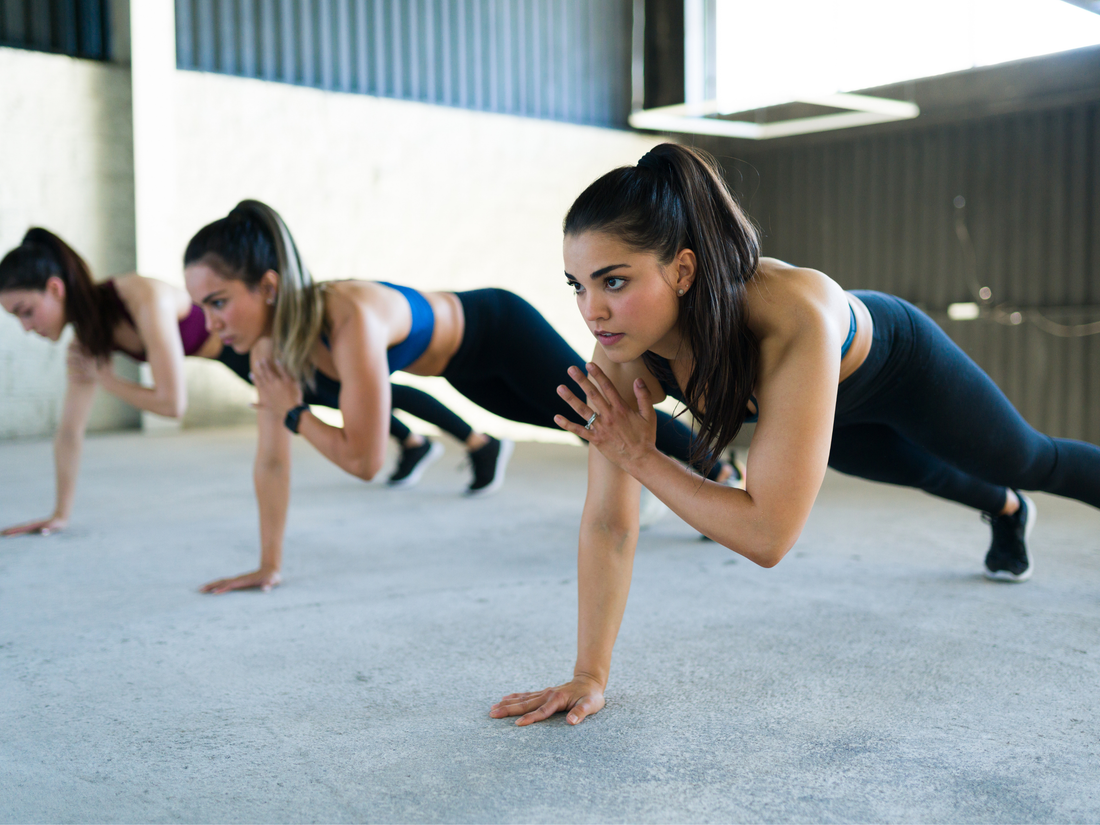HIIT for PCOS: Helpful, Harmful, or Somewhere in Between?
TL;DR
- HIIT can improve insulin sensitivity, body composition, and hormone balance in many with PCOS.
- It may be especially helpful for those experiencing insulin resistance or with a higher BMI.
- Not ideal for everyone, those under high stress or new to exercise may benefit more from gentler movement.
- Success with HIIT depends on recovery, stress management, and listening to your body.

If you’ve been diagnosed with PCOS, you know managing symptoms often involves more than just medication. Nutrition, sleep, stress management, and movement all play a role, but determining the right type of movement can be confusing. High-Intensity Interval Training (HIIT) is a form of exercise that frequently comes up in conversations around improving metabolic health and cardiovascular health.
It’s also often known as the overall best bang for your buck exercise in terms of time and efficiency, but how it fits into PCOS management may depend on individual needs and circumstances.
In this piece, we explore what current research says about the potential benefits and limitations of HIIT in the context of PCOS
But First, What is HIIT, Exactly?
HIIT involves short bursts of intense movement followed by rest or low-intensity movement. Think cycling hard for 30 seconds, then resting for a minute, repeated in rounds.
HIIT May Improve Insulin Sensitivity in PCOS
One of the most consistent findings across multiple studies is that HIIT improves insulin resistance, a key issue in PCOS that affects how the body processes sugar. A 2023 meta-analysis (a large study that combines results from many smaller studies) found HIIT was more effective than moderate-intensity exercise or no exercise at all in lowering insulin resistance (1). They measured this with something called HOMA-IR, a calculation that estimates how well the body is responding to insulin based on fasting blood glucose and insulin levels. These results were rated as moderate to high certainty, meaning researchers are confident the findings apply to a wide range of people (1).
Why it Matters:
For women with PCOS, high insulin levels can cause the ovaries to increase androgen production (think testosterone), which often leads to symptoms like irregular periods, acne, and unwanted hair growth. Improving how your body handles insulin can help break the cycle and encourage healthier hormone balance. Improving insulin sensitivity may support more balanced hormone levels, though responses can vary from person to person.
How HIIT Helps:
HIIT encourages muscle cells to absorb glucose without needing insulin by increasing the activity of something called GLUT-4 receptors. These are proteins that transport glucose from the bloodstream into cells. This process can happen even without insulin, which may support better blood sugar regulation.
Over time, HIIT can also boost the number of insulin receptors and improve how your cells’ mitochondria (the “energy factories”) function, helping your muscles use energy more efficiently.
The meta-analysis also found that HIIT helped reduce BMI, especially in women with PCOS who were classified as overweight or obese (1). In fact, those with higher BMIs tended to see greater benefits in body fat reduction and waist-to-hip ratio improvements (1).
Notably, these changes occurred without requiring weight loss, and in some cases, without a change in diet (1). While this isn’t always true for everyone, it suggests that positive shifts in metabolic health can help even when the number on the scale stays the same. Measuring body composition (like fat mass and muscle mass) may offer a more complete picture than weight alone.
What About Hormones?
Some studies observed reduced total testosterone levels and improved androgen profiles after HIIT (1)(2). One even found a decrease in the testosterone-to-cortisol ratio, which may indicate a more balanced stress and sex hormone environment (3).
These hormonal changes are promising, though results vary depending on the individual, length of workout time, and whether hormonal birth control was used (1). What’s consistent is that improving insulin resistance and reducing visceral fat may help restore more balanced hormone signaling over time.
Does HIIT Raise Cortisol Too Much?
HIIT is intense, and yes, it does raise cortisol during workouts, as all intense exercise does. But the concern is often about chronic elevation of cortisol, not temporary spikes. In fact, one study reported reduced cortisol levels over time, along with improvements in insulin and testosterone (2).
As with any form of exercise, context matters. When the body is well-supported, with adequate rest, nutrition, and recovery, it can often adapt well to short bursts of physical stress like those in HIIT. However, if someone is already dealing with chronic conditions, elevated stress levels, burnout, or irregular cycles, the body may already be under significant physiological strain. In these cases, it may be helpful to start slowly, monitor how the body responds, and prioritize recovery as part of an overall approach to well-being. If it doesn’t feel right for you and your body, then it might not be right.
What If You’re Not Seeing Changes in Insulin?
It’s worth noting that not all studies show improvements in insulin sensitivity across the board. One trial found that while both HIIT and moderate-intensity training lowered testosterone and improved cardiovascular fitness, insulin markers didn’t shift significantly, possibly because participants had relatively healthy metabolic values to begin with (2).
This highlights the importance of individual context. If you’re already metabolically healthy, the benefits of HIIT may be more about cardiovascular and hormonal support, rather than glucose control.
HIIT vs. Moderate Intensity: Which is Better?
You might think HIIT always wins, but studies show that both HIIT and moderate-intensity continuous training (MICT) can deliver similar benefits like (2):
- Boosting your VO₂max (how well your body uses oxygen)
- Lowering your resting heart rate
- Increasing vagal tone (how your vagus nerve influences your body), which is linked to better stress resilience
In one study, MICT looked like a steady workout with a 5-minute warm-up, about 50 minutes at a moderate heart rate (70-80% of max), and a 5-minute cool-down (2). HIIT typically involves short, intense bursts of exercise. Both approaches have potential benefits, with moderate exercise offering advantages when practiced consistently and allowing for adequate rest and recovery
Research Limitations
While the science around HIIT and PCOS is promising, as with much of the research on women, there are some gaps:
- Limited data on women with lean PCOS
- Small sample sizes and varying study lengths (from 8 to 16 weeks)
- Many studies didn’t track diet, which can impact results
- Lack of long-term follow-up to see how sustainable the changes were
- Variability in HIIT protocols and workouts, making comparisons difficult
- Differences in participants’ baseline fitness levels and PCOS baseline symptoms
- Limited diversity in study populations (e.g., ethnicity, age range)
- Potential bias from self-reporting (e.g., symptoms, adherence to workouts)
- Few studies directly comparing HIIT to other exercise forms in PCOS populations
Despite these limitations, the overall research suggests that HIIT may be a helpful lifestyle consideration for improving PCOS symptoms, especially those related to metabolism and insulin resistance.
So, Should You Try HIIT for PCOS?
HIIT May Be a Good Fit If:
- You’re cleared for exercise and want to improve insulin resistance
- You have limited time, but want a meaningful result
- You're not in a high-stress, low-recovery season
- You prefer varied, dynamic workouts that can feel more engaging than steady-state exercise
- You enjoy structured workouts with clear intervals, which can help with motivation and adherence
- You’re comfortable with higher intensity and can recover well between sessions
HIIT May Not Be Ideal If:
- You’re new to exercise or have a low fitness level, making high-intensity bursts challenging or unsafe
- You’re under a lot of psychological or physical stress
- You’re just starting to exercise or recovering from burnout
- You need a gentler approach to begin with (like walking, yoga, or strength training)
- You have a chronic condition, especially those impacting hormonal balance, energy levels, or recovery capacity
Tips for Safely Starting HIIT with PCOS
If you’re considering adding HIIT to your routine, ease into it gradually. Start with shorter intervals and lower intensity to allow your body to adapt, especially if you’re new to exercise or coming off a period of inactivity. Focus on proper form and choose movements that feel comfortable to avoid injury. It can be helpful to work with a coach or trainer familiar with PCOS to tailor workouts to your needs and monitor how your body responds. Remember to listen to your body. If you experience increased fatigue, mood changes, or disruptions in your cycle, it might be a sign to adjust intensity or incorporate more recovery time.
The Role of Recovery and Stress Management in Exercise Success
Exercise is just one piece of the puzzle when managing PCOS. Recovery strategies such as quality sleep, stress reduction techniques, and proper nutrition are essential to support your body’s adaptation to exercise and hormonal balance. Since PCOS is often associated with increased stress sensitivity, combining HIIT with practices like mindfulness, meditation, or gentle yoga can help regulate cortisol and improve overall well-being. Prioritizing recovery ensures that your workouts become a sustainable, positive part of your lifestyle rather than an additional stressor.
Bottom Line
PCOS is a complex condition, and there’s no single best form of exercise for everyone. But high-quality research suggests that HIIT can be a lifestyle tool for improving insulin sensitivity, supporting hormone balance, and enhancing cardiovascular health.
Ultimately, the most important thing is to choose a movement that feels supportive, not depleting. Whether that includes HIIT, strength training, walking, or stretching, consistency and recovery matter more than perfection.




